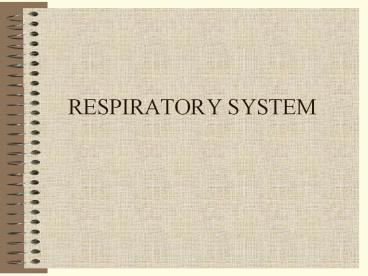RESPIRATORY SYSTEM - PowerPoint PPT Presentation
1 / 44
Title:
RESPIRATORY SYSTEM
Description:
RESPIRATORY SYSTEM RESPIRATORY SYSTEM PHYSIOLOGY continued Expiration (Exhalation) Diaphragm & Intercostal Muscles Relax (nerve stimuli halt) Volume of Thoracic ... – PowerPoint PPT presentation
Number of Views:716
Avg rating:5.0/5.0
Title: RESPIRATORY SYSTEM
1
RESPIRATORY SYSTEM
2
RESPIRATORY SYSTEM FUNCTIONS
- Gas Exchange (pick-up O2, eliminate CO2)
- Filter, Warm Humidify Air
- Protection
- Speech
- Regulate pH
3
RESPIRATORY SYTEM ORGANIZATION
- Upper Respiratory Tract (Outside Thorax)
- Nose
- Pharynx
- Lower Respiratory Tract (Inside Thorax)
- Larynx
- Trachea
- Bronchial Tree
- Lungs
4
(No Transcript)
5
UPPER RESPIRATORY TRACT
- Nose
- External Nares/Anterior Nasal Aperture (nostril)
- Nasal Cavity
- Hairs, Mucus (Trap Debris)
- Mucosa (Warm, Moisten)
- Cilia (Transport)
- Nasal Conchae Bones (Turbulence)
- Olfactory Receptors (Smell)
- Tear Drainage
6
UPPER RESPIRATORY TRACT continued
- Paranasal Sinuses (4)
- Spaces in Bone
- Lined with Mucous Membrane
- Empty into Nasal Cavity
- Light Bone, Resonation
- Internal Nares/Posterior Nasal Aperture (Opening
between Nasal Cavity Nasopharynx)
7
(No Transcript)
8
(No Transcript)
9
UPPER RESPIRATORY TRACT continued
- Pharynx (Throat)
- Between Nasal Cavity Larynx
- Passageway for Air Food
- 3 Divisions
- Nasopharynx (Internal Nares ? Soft Palate)
- Oropharynx (Soft Palate ? Base of Tongue)
- Laryngopharynx (Base of Tongue ? Opening to
Esophagus)
10
(No Transcript)
11
UPPER RESPIRATORY TRACT continued
- Protected by Tonsils
- Pharyngeal Tonsil (Adenoids, Nasopharynx)
- Tubal Tonsils (Nasopharynx, Entrance to Auditory
Tubes) - Palatine Tonsils (Oropharynx)
- Lingual Tonsils (Oropharynx)
12
(No Transcript)
13
LOWER RESPIRATORY TRACT
- Larynx (Hyoid ? Cricoid Cartilage)
- 2 Functions
- Keep Movement of Food Air Separate
- Provide Sound for Speech
- Glottis
- Slit-like Opening into Larynx
- Produces Speech with Vocal Cords
14
Glottis Vocal Cords
15
LOWER RESPIRATORY TRACT continued
- Cartilages
- Epiglottis
- Covers Glottis (opening of larynx)
- Prevents food from Entering Trachea
- Thyroid (Adams Apple)
- Cricoid (Inferior, Encircles Vocal Cords)
16
(No Transcript)
17
LOWER RESPIRATORY TRACT continued
- Trachea (Windpipe)
- C-Shaped Tracheal Cartilage Prevents Collapse
- No Cartilage Posterior, Allows Swallowing
- Bronchial Tree
- Branching Airway
- Carina (Ridge at Bifurcation of Trachea)
- Supported by Cartilage
18
- Primary Bronchi
- ?
- Secondary Bronchi
- ?
- Tertiary Bronchi
- ?
- Bronchioles (Terminal Respiratory)
- ?
- Alveolar Ducts
- ?
- Alveoli
19
(No Transcript)
20
LUNGS
- Paired (spongy) Organs
- Surfaces
- Apex (Superior extension, above clavicle)
- Hilum (Vertical slit on medial surface)
- Cardiac Notch (Recess on left lung)
- Base (Inferior, rests on diaphragm)
21
(No Transcript)
22
LOWER RESPIRATORY TRACT/Lungs continued
- Located in thoracic cavity, lateral to heart,
superior to diaphragm - Protected by pleura (serous membrane)
- Visceral (inner, covers lung surface)
- Parietal (outer, lines thoracic cavity)
23
(No Transcript)
24
(No Transcript)
25
LOWER RESPIRATORY TRACT/Lungs continued
- Lobes
- Right Lung - 3 Lobes Superior, Middle, Inferior
- Left Lung - 2 Lobes Superior, Inferior
- Fissures
- Horizontal Fissure (Between Superior Middle
Lobes, Right Lung) - Right Oblique Fissure (Middle Inferior)
- Left Oblique Fissure (Superior Inferior)
26
(No Transcript)
27
LOWER RESPIRATORY TRACT/Lungs continued
- Alveoli
- Microscopic, Membranous Air Sacs
- Functional Unit of Lungs, Main Site of Gas
Exchange Between Respiratory Circulatory
Systems (by diffusion) - Simple Squamous E.T.
- Surfactant Reduces Surface Tension, Prevents
Collapse
28
(No Transcript)
29
(No Transcript)
30
(No Transcript)
31
RESPIRATORY SYSTEM PHYSIOLOGY
- Pulmonary Ventilation (Breathing)
- Relies on Gas Traveling from High Pressure to Low
Pressure (Negative Pressure System) - 2 Stages
- Inspiration (Inhalation)
- Diaphragm Intercostal Muscles Contract
- Volume of Thoracic Cavity Increases, Pressure
Decreases - Air Rushes into Lungs
32
(No Transcript)
33
(No Transcript)
34
RESPIRATORY SYSTEM PHYSIOLOGY continued
- Expiration (Exhalation)
- Diaphragm Intercostal Muscles Relax (nerve
stimuli halt) - Volume of Thoracic Cavity Decreases, Pressure
Increases - Elastic Recoil of Tissues
- Air Rushes out of Lungs
35
RESPIRATORY SYSTEM PHYSIOLOGY continued
- Respiratory Volumes
- Tidal Volume (Amount in Single, Relaxed Breath or
Breathing Cycle, ?500 ml) - Inspiratory Reserve Volume (Amount Forcibly Taken
in Above TV, ? 3,000 ml) - Expiratory Reserve Volume (Amount Forcibly
Exhaled after TV, ? 1,000 ml) - Residual Volume (Always Remains in Lungs)
- Vital Capacity (Max. Amount Exhaled, TV IRV
ERV, ? 4,500 ml)
36
(No Transcript)
37
RESPIRATORY SYSTEM PHYSIOLOGY continued
- Gas Exchange (Respiration)
- Occurs Across Respiratory Membrane (Alveolar Wall
Capillary Wall) - Alveolar ducts Respiratory Bronchioles also
sites of exchange - Gases Diffuse from Area of High ? Low
- O2 Bound to Hemoglobin some in plasma
- Chemoreceptors in Aorta Carotid Arteries
38
RESPIRATORY SYSTEM PHYSIOLOGY continued
- CO2 Transport
- Bicarbonate Ion (HCO3-) in RBCs
- Attached to Hemoglobin
- Plasma
39
(No Transcript)
40
(No Transcript)
41
(No Transcript)
42
RESPIRATION
- Occurs in two locations
- External Respiration
- Between Alveoli Pulmonary Capillaries
- O2 diffuses into blood CO2 diffuses out
- Internal Respiration
- Between Systemic Capillaries Interstitial
Spaces - O2 diffuses out of blood CO2 diffuses in
43
(No Transcript)
44
Control of Breathing
- Respiratory Regulatory Center
- Medulla sets the basic rate rhythm
- CO2 changes (pH) act as primary stimulus
- Pons smooths respiratory pattern
- Chemoreceptors
- Medulla oblongata monitors CO2 pH of CSF
- Aorta Carotid Artery detect changes in oxygen
concentration
45
(No Transcript)































